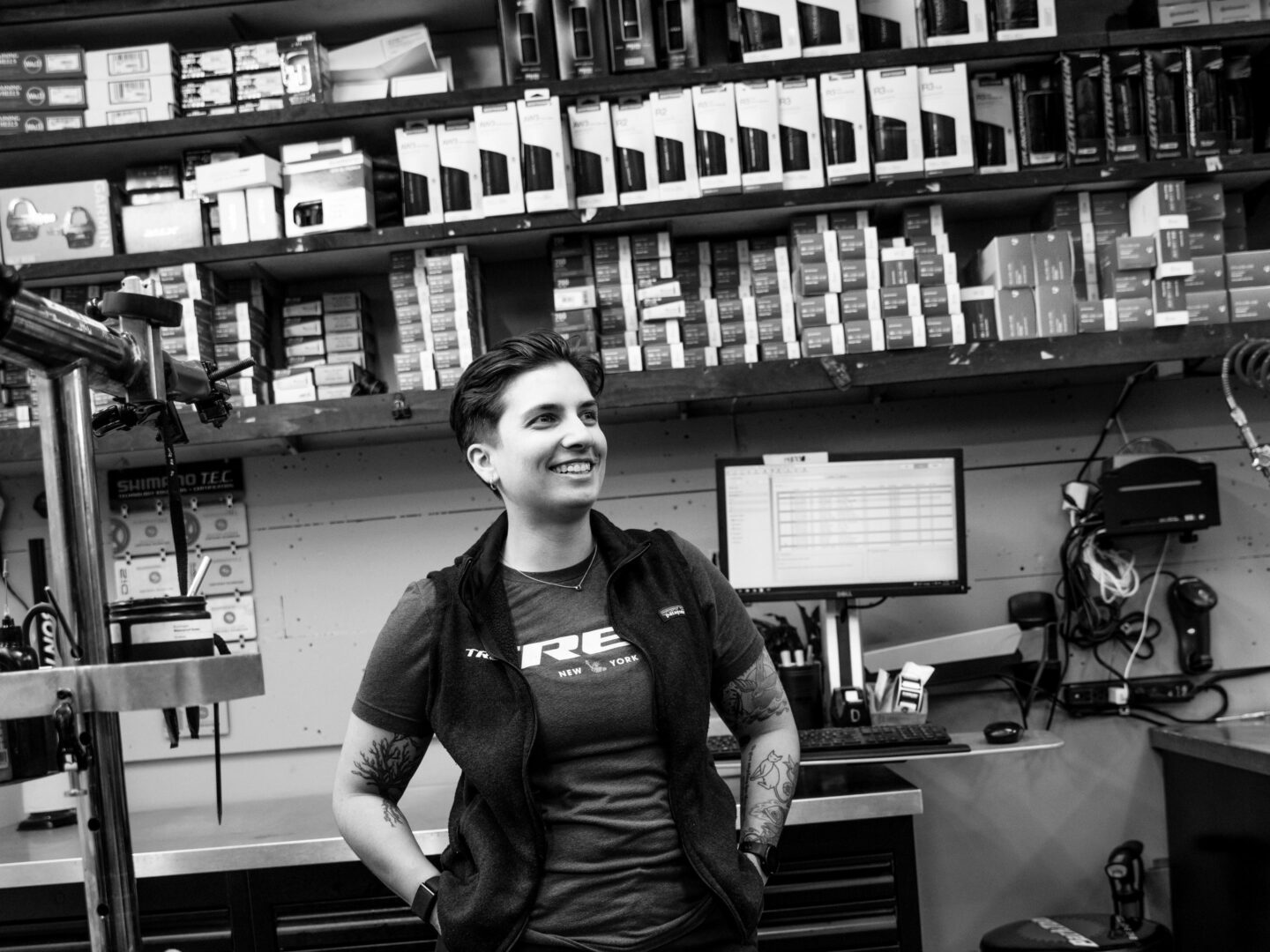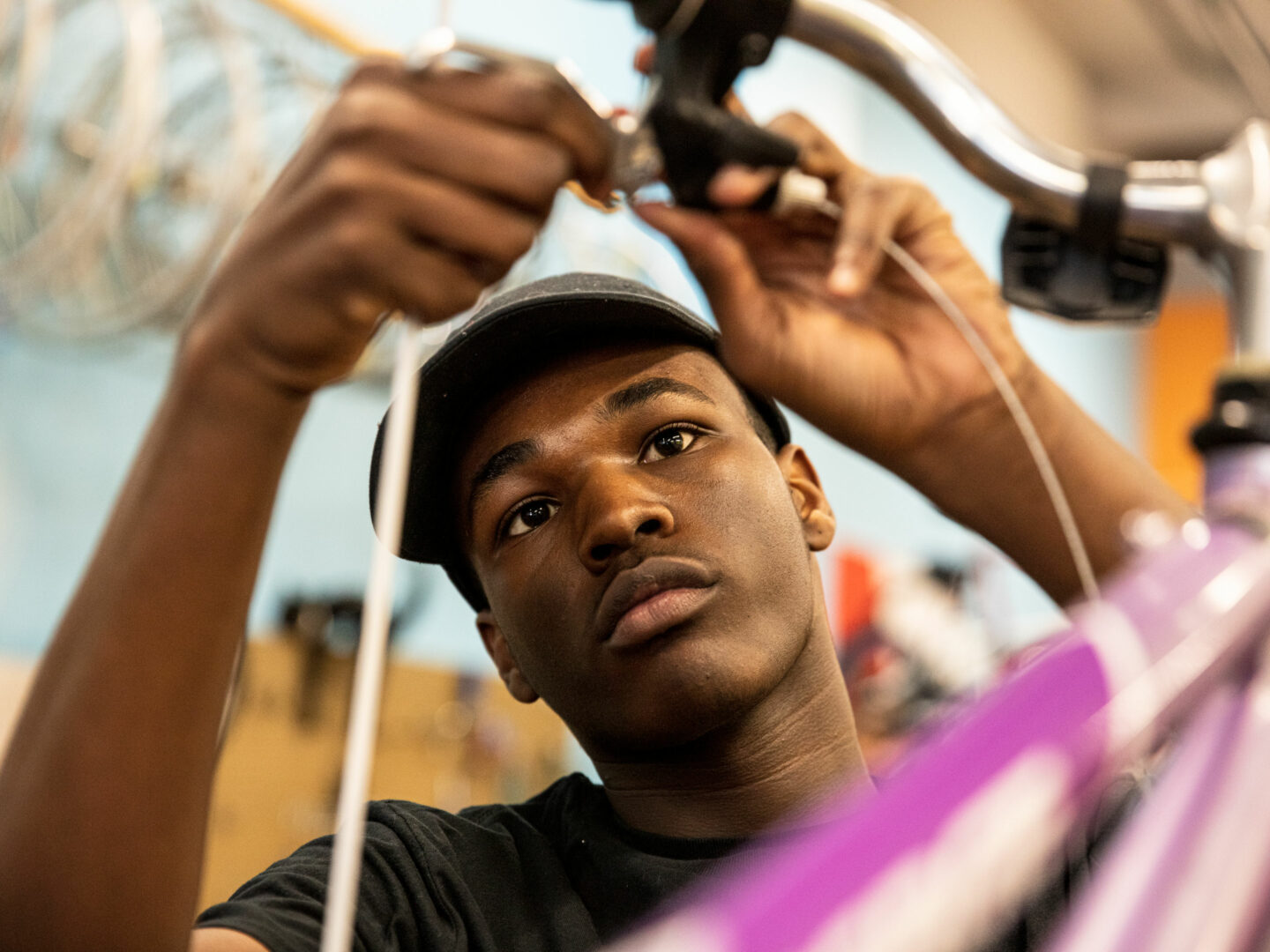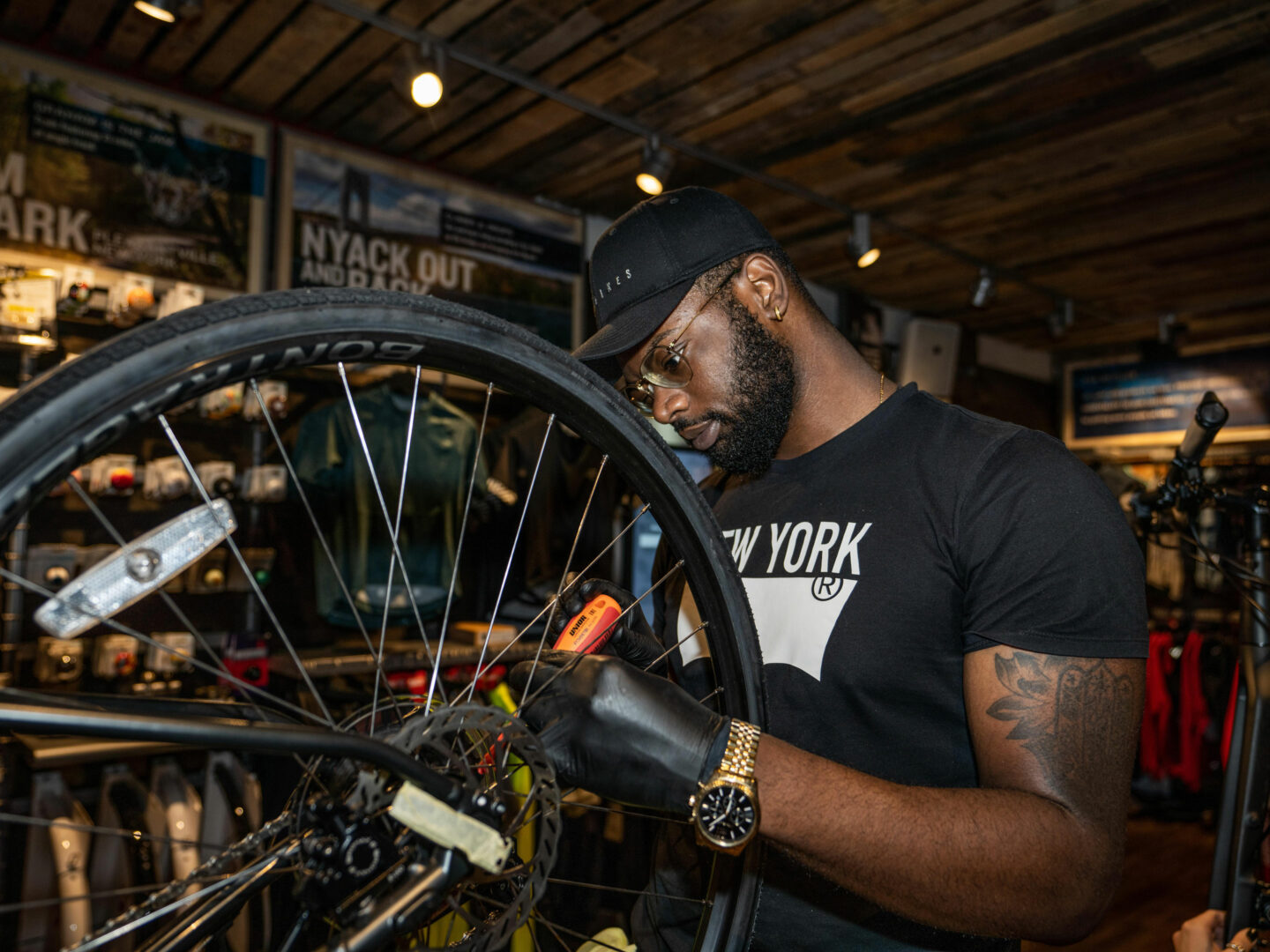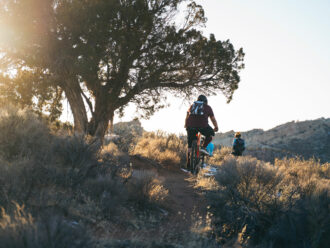- Responsibility
- Advocacy
- 14 June, 2022
Together we ride further These mentors are changing the world one wrench at a time
Changing the world starts when we begin pedaling forward, and just as with group rides, we can go so much further when we ride together.
This is more apparent than ever when looking at the All In Development Program and the team of mentors, planners, and doers working to build a brighter future for bikes. Together, these passionate leaders are putting a plan into action to end systemic racism and elevate diversity in cycling by providing opportunities for youth in underserved communities to learn how to work on bikes.
The All In Development Program started with the passion of Tati Koufopanteli, who manages a Trek store in Upper West Side Manhattan, but took off thanks to the hard work and dedication of a team of mechanics and store managers who volunteer their time to help build curriculum, teach, and even give rides to students. The program provides education to at-risk youth and youth in underserved communities so they can learn skills that transfer into the workplace. At the end of the program, every student who graduates is offered a job at a Trek store, whenever they’re ready to take it.
We sat down with Forest Cutrer and Elena Chesnutt, two of the dedicated women behind the All In Development Program who spend their free time teaching teenagers skills they can take to the workforce, school, and life beyond.
What is your history working with bikes, and what was your background before joining All In?
Forest: I’m 36 and I got my first bike as a grown-up when I was 21 so it’s been 15 years. I lived in Tempe, AZ, which is where Arizona State is, and where I got my degree. Shortly after I got [my bike] I started hanging out with a bunch of friends I met who were starting a bike cooperative. And so I joined them and they taught me everything that they knew, and then within a few months, I was also teaching people from the community how to fix bikes, how to strip junkyard bikes, how to make stuff. We were doing all sorts of fun things, welding things, building stuff.
I was a board member and helped develop it to be much bigger, and it’s now a huge integral part of the community. I don’t think there are any original members left. I was checking in on it the other year and it’s huge now and that’s really awesome. Anyway, after that, I moved here, so I was just kind of like super into bikes, and I started working at a multi-sport shop downtown. And then that’s when I started getting paid to work on bikes because we had a little bike shop in it. I managed their bike department for, like, six years.
Elena: I have only been in bikes for a little over two years. I came from the cooking world, I was in restaurants for about 10 years before working at Trek… I really loved riding bikes. Well, I still do, but it was kind of like a hobby for me then, and then I just turned my hobby into my job, which is cool. I got hired as an assembler at the beginning of the pandemic because I needed a job and this was one of the only industries that were hiring at the time. And then I worked my way up to service manager, which is really cool.
Why did you decide to get involved with the All In Development Program?
Forest: Honestly, it was just because we felt like we needed to do something. I remember summer of 2020 in New York City. There was just so much going on. It was at the height of all the protests and stuff. There were some whispers going about, like, “Hey, we need to do something. We’re working at one of the largest bicycle companies in the country, if not the world, let’s do something.”
Most of us kind of came from other people teaching us how to work on bikes… it kind of broadened our opportunities. I wish I could take more credit for it, but honestly, a huge part of creating All In was the store manager at 96th St, Tati, she pulled us aside one day and she’s like, “This sucks. Let’s do something. Let’s teach kids from the city who would otherwise not have any job prospects as of right now, how to work in a technical field that’s fairly stable, and let’s just teach them how to do it and let’s figure it out.”
And so, we had a few meetings. It took a while to get off the ground, but I think we realized that if we just kind of put our heads together locally and hammered out a plan we could present it [to Trek]. Tati did a ton of the legwork, but it was definitely a huge team effort to get going. We just got sick of not doing anything, so we just started doing stuff to help kids.
Elena: When I got moved into the service manager position and I got on these calls that we have biweekly, I remember Forest mentioning that this was happening and I was like, “I haven’t even heard of this. What are you talking about? I wanna be involved!” So I was immediately like, “Yes, absolutely. I’m on board.”
I think that has a lot to do with the whole Black Lives Matter movement, and that’s something that’s super important here in New York. I feel like we are a pretty diverse community here, especially with who is working in our stores and I think trying to help the community around us that otherwise wouldn’t have the opportunity is amazing. I was like, “I would love to be involved with that.”
Can you tell us what the structure of the course looks like?
Forest: There are nine total weeks with a week that was a rest week… But it’s like eight weeks of classes. 2021 was the first time that we did it, Andrew Tablante, from our Cobble Hill location, put together kind of a rough curriculum and it paralleled the assembly school curriculum that I think Chris Lynch had developed. I think it was a revision that he’d put out, and Tablante was like, “Yeah, this is it. This works.” And so we kind of mirrored it off of that because the goal was to get these students to become assemblers. But you know, there were some kinks to work out.
The next time through, I put together a curriculum because we realized after having one of the students come to my store, Matt(Hew) Chung, he was an assembler, then he was an on-the-spot technician, and then he became a service advisor. And we were like “Oh, so the potential for this is a lot higher. We need to shoot a little higher with what we teach them, rather than underselling it. Maybe if we have a longer program we can use that time to get more knowledge into these students’ heads.”
So the curriculum that I created is a lot more structured because now we’ve got classes two days a week instead of just the one. So we break it up and I had a lot of hit points that I wanted us to go over. It was loosely based on the curriculum that I used to teach at the co-op in Arizona combined with Trek University and some of the order of the assembly school curriculum, and we worked out some of those kinks.
I’m currently working on a tighter curriculum for next year so that each time we’re getting tighter and tighter. The goal is to have it so that we can plan out every 15, 20, or 30 minutes, just like when you’re a teacher at a school. Making sure you have certain things planned out that you need to go over, and the kids need to retain. I’m kind of thinking of it from the same perspective, I guess. I thought I was going to be a teacher for like a year in college, so maybe this is my chance.
Of all the different things you teach in the course, what do you feel makes the biggest difference to the students learning from you?
Forest: The thing that I noticed the most was the students learning the confidence to do something, to put themselves in a situation where they don’t know what they’re getting into, and to get frustrated and still figure it out. When they would get stuck on something, like a front derailleur or something, cause everyone hates those, and just get almost to the point like they would get really frustrated. I had this one kid in my class, he was super smart, but he would get really frustrated when something wouldn’t go his way and it was like, “OK, no, we’re gonna be calm. We’re gonna think, we’re gonna start over. I’m gonna think about it step by step,” and then he would do it and he would nail it.
And every single student in my class has had that moment. It’s like light bulbs go off in their head whenever they actually do it. It’s so cool. When I was first learning how to fix bikes like that was a huge part of it for me, and that just changed the way that I saw the world and I’m more willing to just get into situations where I don’t know how good I’m gonna be, but you know that you can figure it out. So it’s very much not bicycle-specific, but bikes are a really good vehicle for that I think.
What are the biggest challenges you think students face when coming into the program?
Forest: From what I’ve seen, it’s just the time commitment, it’s one more or two more appointments that they have to deal with on top of school, on top of whatever sports on top of whatever musical, our extracurricular stuff they’ve got. In the first round in 2021, we had a lot more at-risk youth who lived a lot farther from the city, and while they maybe didn’t have as many extracurricular things going on for them, it was still a time thing because they had to take care of their siblings. They had to, you know, stay out of trouble. They had to do a lot of learning stuff on their own. And part of that is also figuring out how to get to places where you need to be and be self-motivated. As someone who would have been considered a troubled youth, I know it’s a really hard thing to have that self-motivation to know “OK, I need to do this. I might not want to. It might not always be tons of fun, but I should do this,” and actually following through with it.
Did you have any stand-out favorite moments or takeaways from the program?
Elena: I got to deliver the bikes with Tati at the end of last year, which was really fun. I mean, it was a long day, but it was really, really fun. Driving around Queens and delivering them, the kids were so happy and so excited, and that was really great. I got to deliver [a student’s] to him this year because he wasn’t able to make it to graduation and he was so excited. It was on his birthday, which was really cool. The kids being excited about the bikes, think that’s the best part.
Forest: I think my answer is actually just spending the first, you know, 20 minutes actually just talking to them about what’s going on. It kind of made me feel like a cool aunt. It was just like,
“What did you do this week?”
“Oh, nothing.”
“Well, what do you mean, nothing. Did you just sit in your bed and, like, stare at the ceiling?”
And they’d be like, “No. Well, actually did this and this and this.”
And it’s getting them used to sharing with adults and talking to adults. And I really, I genuinely like that.
Where do you hope the program will go from here?
Forest: Everywhere.
Elena: Yeah, every city needs it.
Forest: I hope it can be in all 50 states in every major city. I mean that’s a huge dream. But the idea is to make it replicable and easy to transfer and hopefully in, you know, five or ten years, this is just like, “Oh yeah, that’s that thing that we do,” like we have our stores in whatever city and this is just part of the responsibility of having those stores.
Aside from joining All In, is there anything you think that every bike shop should be doing to elevate inclusivity in the bike world?
Forest: Inclusivity in bike shops, I think, is something that’s been a struggle forever. It’s a really male dominant place, and it’s also a very white male-dominated place and so breaking that mold, it’s going to take a lot of just chipping away at it. I think on a store level, aside from seat changes that have been happening and will continue to happen, shops need to hire people who look like the people in the community, and focus on having a more outwardly diverse staff.
At upper West 96th, it’s like a mixed bag of jellybeans in terms of the staff who work there. We all come from different places. We all come from different backgrounds. We all look different, and we live in a super diverse neighborhood, too. So, when a customer comes in, I’ve noticed they’ll kind of gravitate towards the person that they feel like they vibe with right on the spot. And that’s really cool because I think if we didn’t have that particular staff member on the team, that person might not have engaged. That person might not have learned whatever they learned that day… It’s beneficial on every single level. It improves the general bicycle knowledge of the community… it allows us to do more with what we have.
Elena: Yeah, it’s really simple, but I think treating everyone the same, no matter what they look like makes a big difference. Giving the same respect to everyone whether they’re buying this $10,000 bike or if they have a $200 bike is super important. I think also doing more events in the shop that cater to different kinds of people in your community can help different people feel more included and welcome in the space.






